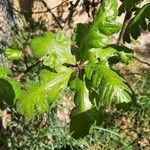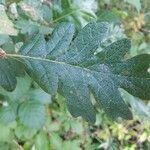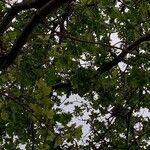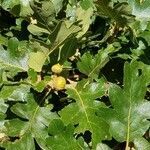Trees or shrubs , deciduous, trees to 15(-20) m, with solitary trunks, shrubs to 0.1-3 m, multitrunked. Bark light gray or almost white, scaly. Twigs brown, red, or yellowish, 2-4 mm diam., densely puberulent with spreading hairs or glabrate. Buds brown or yellowish, ovoid or fusiform and apex acute, 2-12 mm, glandular-puberulent or densely pubescent. Leaves: petiole 4-10 mm. Leaf blade obovate, elliptic or subrotund, moderately to deeply lobed, 25-120(-140) × 15-85 mm, base rounded-attenuate or cuneate, rarely subcordate, often unequal, margins with sinuses usually reaching more than 1/2 distance to midrib, lobes oblong or spatulate, obtuse, rounded or blunt, larger lobes usually with 2-3 sublobes or teeth, veins often ending in retuse teeth, secondary veins yellowish, 4-7 on each side, the more distal veins often branching within distal lobes, apex broadly rounded; surfaces abaxially light green or waxy yellowish, often felty to touch, densely to sparsely covered with semi-erect or erect, simple and (2-)4-8-rayed, fasciculate hairs 0.1-1 mm, secondary veins raised, adaxially bright or dark green, glossy or somewhat scurfy because of sparse stellate hairs. Acorns 1-3, subsessile, rarely on peduncle to 10(-20) mm; cup saucer-shaped, cup-shaped, or hemispheric, 4-10 mm deep × 12-22 mm wide; scales yellowish or reddish brown, often long-acute near rim of cup, moderately or scarcely tuberculate, canescent or tomentulose; nut light brown, oblong to globose, (12-)25-30(-40) × (10-)14-20(-22) mm, apex blunt or rounded, glabrous or often persistently puberulent. Cotyledons distinct. 2 n = 24.
More
A small tree. It grows to 20 m high. The trunk is 150 cm across. The leaves are thick and stiff. They are 7-10 cm long. There are 5-7 lobes. These are rounded and have deep notches. The upper surface is shiny green and dull green underneath. The stalk is 1-3 cm long. The acorns are 25-30 mm long. They can occur singly or in pairs. The stalks are 1-3 cm long.
Found in a variety of inland sites, including upland slopes, exposed ridges and open valley bottoms, in mixed evergreen forests, conifer forests, inland in its own open woodland community, or as a large shrub among pines, firs and junipers.
More
It is a temperate plant. It grows on dry rocky ground. It will also grow on coastal sites as long as it is not affected by tidal flooding. It cannot tolerate shade. It suits hardiness zones 5-10.





